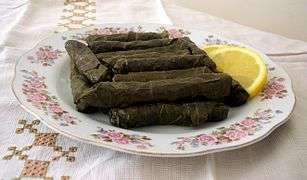Sarma (food)
Sarma (Turkish word "sarmak", meaning "to wrap"; Cyrillic: Сарма) is a dish of vine, cabbage, monk's rhubarb or chard leaves rolled around a filling usually based on a combination of grains, like bulgur or rice, and minced meat. It is found in the cuisines of the former Ottoman Empire from the Middle East to Southeastern Europe.
 Yaprak sarma | |
| Type | Dolma |
|---|---|
| Place of origin | Turkey |
| Region or state | Middle East, South Caucasus, Balkans, and Central Asia |
| Serving temperature | Cold or hot |
| Main ingredients | Vine leaf, rice |
| Variations | With cabbage leaves |
Stuffed vine leaves
 | |
| Region or state | Turkey, Lebanon, Iraq, Armenia, Greece, Balkans, Levant, Egypt, Azerbaijan, Caucasus, Iran, Saudi Arabia |
|---|---|
| Serving temperature | Hot and Cold |
A vine leaf roll is a dish consisting of cooked grape-vine leaves wrapped around a variety of fillings. It is common to the cuisines of Armenia, Azerbaijan, Iraq, Turkey, Lebanon, Israel, Saudi Arabia, Jordan, Syria, Palestine, and Iran, but is also known in the Balkans, especially in Bosnia and Herzegovina, Romania, Bulgaria and Greece, where it may be served with mashed potatoes and yogurt.
Vine leaf rolls are called yaprak sarması (lit. 'leaf sarma') or yaprak dolması (lit. 'leaf dolma') in Turkey or dolma in Armenia and Greece, yarpaq dolması (lit. 'leaf dolma') in Azerbaijan,[1] dolmades (ντολμάδες, sg. dolmas ντολμάς) in Greece, and dolme barg mo (دلمه برگ مو, lit. 'vine leaf dolma') in Iran and warak e’nab (ورق عنب) or warak dwali (ورق دوالي) in Arabic.
Stuffed vine leaves without meat are sometimes called yalancı dolma, which means "liar's dolma" in Turkish.[2] Vişneli yalancı dolması is a variation of stuffed vine leaves where the rice is seasoned with cinnamon, allspice and mint. The dolmas are slowly cooked together with morello cherries (vişne), and plums may be used also.[3] In a version from the Turkish chef Arda Türkmen, the rice is cooked in morello cherry juice with spices, sour pomegranate syrup (nar ekşisi), currants and toasted pine nuts.[4]
Vine leaves may also be used to wrap stuffed celery root. Before wrapping, the celery root is stuffed with rice that has been seasoned with cinnamon, salt, pepper, allspice, pine nuts and sugar. (This type of rice is called iç pilav.) Dried fruits like fig and apricot may be added to the rice mixture before the celery root is stuffed, wrapped and baked in the oven.[5] Some variations may include quince.[6]
In Balkan countries, yaprak (Bosnian: japrak; from Turkish: yaprak, "leaf"[7]) is a generic name for meals made of grape (especially Sultana grape) leaves (a kind of kale), stuffed with meat (beef or lamb) and rice, or more rarely rice only. Meals are called as Yaprak Sarma or Yaprak Dolma. In Balkans broccoli leaves are sometimes used instead of grape leaves.
Stuffed chard leaves
Stuffed chard leaves are called pazı dolması in Turkey[8] and dolmas de pazi by Sephardi Jews who settled in Argentina.[9]
Sarma in Amasya and Tokat
In the Turkish provinces of Amasya and Tokat sarma is prepared in a style similar to maklouba, with different fillings. One version made with fava beans is called bakla sarma. The filling for this variant from Amasya is made with dried fava beans and a coarsely ground wheat called yarma. Tomato paste, water, sunflower oil, chopped onion, aleppo pepper and spices are added to complete the mixture. Bone-in lamb chops are tightly layered on the bottom of the pot and the wrapped sarma are added on top of the lamb. Butter is added on top and the sarma are cooked together with the lamb chops in water. The finished dish is served upside down.[10] A similar variation from Tokat is stuffed with a lentil, bulgur and chickpea filling. Homemade red pepper paste may be substituted for some of the tomato paste.[11]
In Romania and Moldova
In Romania and Moldova, sarmale is popular in all historical regions, Moldavia, Transylvania, and Wallachia. It usually consists of minced pork, rice, eggs, and spices (paprika, salt, black pepper) rolled in a cabbage leaf (usually whole sour cabbage) or vine leaves. It is typically accompanied by mămăligă (polenta) and smântână (sour cream).
See also
- Buntil
- Cabbage roll
- Gołąbki
- Holishkes
- Vine leaf roll
- List of cabbage dishes
- List of stuffed dishes
References
- "Yarpaq dolması". Resept.az (in Azerbaijani). Archived from the original on June 25, 2019. Retrieved July 11, 2019.
- Marks, Gil (2010-11-17). Encyclopedia of Jewish Food. HMH. ISBN 978-0-544-18631-6.
- "Vişneli Yaprak Sarma tarifi - Haber - Mutfağım". Kanal D. Archived from the original on 2014-01-18. Retrieved 2018-06-29.
- Arda'nın Mutfağıundefined (Director). ARDA'NIN RAMAZAN MUTFAĞI VİŞNELİ SARMA VE ŞERBETLİ GÜL TATLISI. Event occurs at 1322 seconds. Retrieved 2018-06-29.
- "Zeytinyağlı, Kuru Meyveli Kereviz Dolması". Sabah. Retrieved 2018-06-30.
- Nursel'in Evi. Ayvalı Kereviz Dolması Tarifi. Retrieved 2018-06-30.
- FoodReference.com - Yaprak
- Migros Türkiye. Üçgen Pazı Dolması. Retrieved 2018-06-29.
- Diner, Hasia R.; Cinotto, Simone (2018). Global Jewish Foodways: A History. U of Nebraska Press. ISBN 978-1-4962-0609-1.
- Show TVundefined (Director). Nursel'in Mutfağı - Baklalı Dolma Tarifi / 25 Şubat. Event occurs at 738 seconds. Retrieved 2018-06-29.
- "Mercimekli Yaprak Sarma tarifi (Tokat) - Haber - Mutfağım". Kanal D. Archived from the original on 2014-04-11. Retrieved 2018-06-29.
External links
| Wikimedia Commons has media related to Sarma. |
- Heike Milhench (2007). Flavors of Slovenia: Food and Wine from Central Europe's Hidden Gem. Hippocrene Books. p. 142. ISBN 978-0-7818-1170-5.
- Sarma made in Bosnia
- Sarma made in Serbia
- Sarma made in Romania